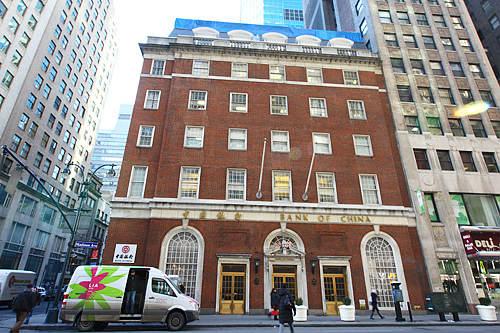
Offshore market: Bank of China's New York branch (pictured) has allowed companies and individuals to buy and sell the yuan since January 2011 [WU KAIXIANG]
Although China has made headway in reforming the exchange rate regime of its currency, the yuan, and expanding the use of it in cross-border trade during the past year, the yuan is far from fully convertible. Huang Yiping, a professor at the National School of Development of Peking University, said in an article for Beijing Review that China has the conditions for capital account liberalization and should strive for basic convertibility within five years. Edited excerpts follow:

In December 1996, the governor of the People's Bank of China, the central bank, wrote to the then managing director of the IMF to outline China's goal of realizing current account convertibility. At that time, Chinese officials planned to achieve capital account convertibility within a decade. But it was repeatedly delayed after the Asian financial crisis in 1997.
Ten years later, the world was struck by the U.S. subprime crisis and global economic recession. The Chinese economy performed relatively better compared to other countries in terms of recovering. Clearly, restrictions on cross-border capital flows also helped shield China from external economic and financial shocks.
These raise an important question: Is an open capital account really what China needs? The Chinese experience during the recent global financial crisis suggests that certain degrees of state intervention might be useful for maintaining economic stability. So why liberalize what apparently already works?
Findings from empirical studies on the benefits of capital account liberalization are also inconclusive. Some found positive impacts, some revealed no effect and yet others yielded mixed results. Pooling international data also showed no clear correlation between openness of the capital account and growth performance.
These results cast doubt on the conventional wisdom that the capital account and financial liberalization should help increase investment returns, reduce financial risks and improve growth performance.
So should China pursue its long-planned agenda of capital account liberalization? I approach this question by looking into three broad issues.
First, given that the economy is becoming increasingly open, how effective are the remaining restrictions on cross-border capital flows? Second, while capital controls were probably useful for maintaining domestic economic and financial stability in the past, what are the costs of not liberalizing? Third, if capital account convertibility is the right policy direction, is China ready to pursue it and what liberalization strategy should China adopt?
China has steadily liberalized capital account controls in recent years and the effectiveness of remaining controls has declined. Our estimates of short-term capital flows, which are subject to most severe restrictions, grew exponentially during the past decade. Empirical analyses also indicate that the controls are ineffective in the long run.
Also, remaining restrictions on cross-border capital flows impact negatively on economic growth and affect independence of monetary policy. Although the restrictions helped shield the economy from external shocks, they actually contribute to domestic fiscal and financial risks by allowing irresponsible lending and borrowing behaviors to flourish.
Meanwhile, without capital account convertibility, it is impossible for China to achieve other goals, such as internationalization of the yuan, turning Shanghai into an international financial center and including the yuan in the IMF's special drawing rights basket.
China already possesses the necessary conditions for capital account liberalization and should push forward the reforms within the next five years. In fact, the macroeconomic and financial conditions in China today are already much better than those in India and Russia when they opened up their capital accounts. Importantly, favorable conditions, such as healthy fiscal condition and external surplus, may disappear over time. The 12th Five-Year Plan (2011-15) provides a rare historic opportunity for China to accomplish this reform. The government should first establish market-based interest rates and exchange rates and then lift most restrictions on cross-border capital flows, although special schemes for portfolio investment could remain in place for a while.
1 2 Next




